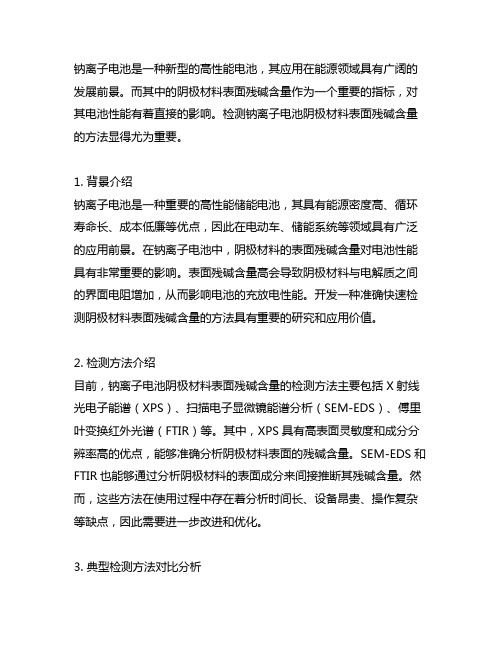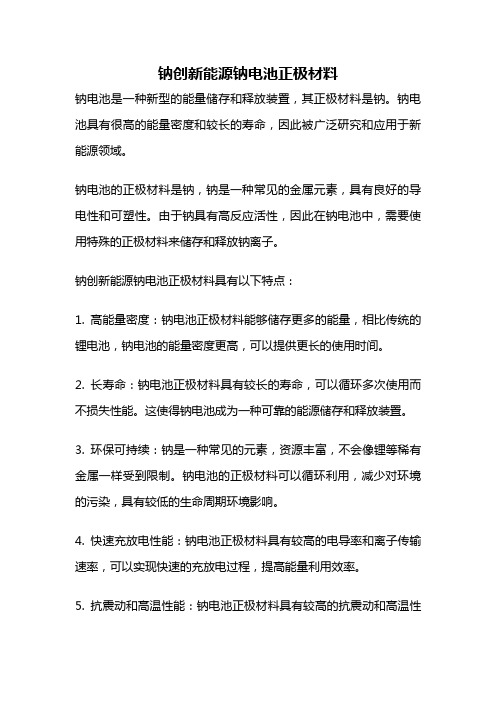2016最新-钠离子电池:储能电池的一种新选择
钠离子电池的电解质

钠离子电池的电解质朱娜;吴锋;吴川;白莹;李翌通【摘要】作为一种新型的储能电池体系,钠离子电池具有资源丰富、成本低、比容量较高等优点,近年来引起了全世界范围内的广泛关注.电解质是制备高性能,长循环寿命,安全性良好的钠离子电池的关键材料之一.本文简要介绍有机电解质、水系电解质、离子液体电解质、固体聚合物电解质、无机固态复合电解质和凝胶态聚合物电解质等体系在钠离子电池中的研究进展,讨论这些电解质体系的电导率、电化学窗口、热稳定性等特点.目前应用在钠离子电池中较为成熟的是有机电解质,展现了良好的综合性能,但安全性仍有待改善.而安全性能较好的离子液体电解质、固体电解质及凝胶态电解质还有许多基础科学需要探索,并且需要考虑成本、电导率、机械强度等诸多因素.基于上述评述,展望了钠离子电池电解质的未来发展.【期刊名称】《储能科学与技术》【年(卷),期】2016(005)003【总页数】7页(P285-291)【关键词】钠离子电池;液体电解质;离子液体;固态电解质;凝胶电解质【作者】朱娜;吴锋;吴川;白莹;李翌通【作者单位】北京理工大学材料学院,环境科学与工程北京市重点实验室,北京100081;北京理工大学材料学院,环境科学与工程北京市重点实验室,北京100081;北京理工大学材料学院,环境科学与工程北京市重点实验室,北京100081;北京理工大学材料学院,环境科学与工程北京市重点实验室,北京100081;北京理工大学材料学院,环境科学与工程北京市重点实验室,北京100081【正文语种】中文【中图分类】O646.21随着人类对能源的依存度不断提高,能源危机、资源匮乏、环境污染的压力日益加剧,人类面临的首要难题是要改变不合理的能源结构,开发清洁能源代替化石能源,如风能,太阳能等。
但是这类可再生能源受到外界自然条件的限制,一般都具有随机性、间歇性、能量密度低等特点,如果将其产生的电能直接输入到电网,会对电网产生很大的冲击[1]。
储能电池产品分类

储能电池产品分类储能电池是一种能够将电能储存起来,待需要时再释放出来的设备。
随着可再生能源的快速发展,储能电池作为一种重要的技术手段,逐渐得到了广泛应用。
在储能电池市场中,不同类型的产品有着不同的特点和应用场景。
本文将对常见的储能电池产品分类进行详细介绍。
一、铅酸蓄电池铅酸蓄电池是最早被广泛应用于储能领域的电池之一。
它具有价格低廉、技术成熟、可靠性高等优点,在家庭和小型商业应用中仍然得到了广泛使用。
铅酸蓄电池主要分为两种类型:深循环铅酸蓄电池和浮充式铅酸蓄电池。
1.深循环铅酸蓄电池深循环铅酸蓄电池主要用于需要经常进行深度放电和充电的场合,如家庭太阳能光伏系统等。
它具有长寿命、高效率、低成本等特点,但其容量较小,体积较大,需要定期维护。
2.浮充式铅酸蓄电池浮充式铅酸蓄电池主要用于需要长时间备用电源的场合,如UPS、通讯基站等。
它具有容量大、寿命长、自放电率低等特点,但其深度循环性能较差,需要经常进行浮充维护。
二、锂离子储能电池锂离子储能电池是近年来发展最快的一种储能电池。
它具有高能量密度、轻量化、长寿命等优点,在家庭和商业应用中逐渐得到了广泛应用。
锂离子储能电池主要分为三种类型:磷酸铁锂电池、钴酸锂电池和三元材料锂离子电池。
1.磷酸铁锂电池磷酸铁锂电池具有安全性好、寿命长等特点,在家庭和商业应用中得到了广泛应用。
它的缺点是比较重,所以不适合移动式应用。
2.钴酸锂电池钴酸锂电池具有能量密度高、功率密度高等特点,在电动汽车等领域得到了广泛应用。
它的缺点是价格较高,寿命较短。
3.三元材料锂离子电池三元材料锂离子电池具有能量密度高、寿命长等特点,在家庭和商业应用中逐渐得到了广泛应用。
它的缺点是价格较高,需要进行严格的安全控制。
三、钠离子储能电池钠离子储能电池是一种新型的储能电池技术,与锂离子储能电池相比,钠离子储能电池具有成本低、资源充足等优点。
钠离子储能电池主要分为两种类型:硫化物钠离子电池和氧化物钠离子电池。
钠离子电池项目计划书

钠离子电池项目计划书1. 项目背景和意义- 钠离子电池作为新型储能电池,具有低成本、高安全性和环境友好等优势,是新一代储能电池的有力竞争者。
- 随着可再生能源的不断发展,对高性能、低成本储能电池的需求日益增加,钠离子电池有望在这一领域发挥重要作用。
2. 项目目标- 开发出高能量密度、长循环寿命的钠离子电池。
- 建立钠离子电池的关键材料和工艺技术。
- 实现钠离子电池的小规模试产和中试。
3. 技术路线- 正极材料研究:开发高电压、高比容量的正极材料。
- 负极材料研究:开发高比容量、高倍率性能的硬碳负极材料。
- 电解液体系研究:开发高离子电导率、高电化学窗口的电解液体系。
- 电池集成与优化:优化电池结构设计,提高电池性能。
4. 预期成果- 建立钠离子电池关键材料和工艺技术。
- 实现钠离子电池的小规模试产和中试。
- 形成钠离子电池的知识产权和技术储备。
5. 项目进度安排- 第一年:正负极材料和电解液体系研究。
- 第二年:电池集成与优化,小规模试产。
- 第三年:中试放大,产业化准备。
6. 项目团队- 组建具有丰富经验的跨学科研究团队,包括材料科学、化学、电化学等领域的专家。
- 与相关企业建立产学研合作关系。
7. 预算和资金来源- 详细列出项目所需的人力、设备、材料等费用。
- 申请政府资助项目、企业合作项目等资金来源。
以上是钠离子电池项目计划书的大致框架,需根据实际情况进一步完善和细化各部分内容。
该项目计划书旨在阐明项目的背景意义、目标任务、技术路线、预期成果等,为项目的顺利实施奠定基础。
储能电池名词解释

储能电池名词解释
储能电池是一种用于储存能量的电池,它能将电能转化为化学能,并在需要时再将化学能转换为电能释放出来。
以下是几个储能电池的常见名词解释:
1. 锂离子电池(Lithium-ion battery):一种使用锂离子在正负极之间的移动来储存和释放电能的电池。
2. 镍镉电池(Nickel-cadmium battery):一种使用镍氢化物和氢氧化镉的化学反应来储存和释放电能的电池。
3. 铅酸电池(Lead-acid battery):一种使用铅和铅二氧化物之间的反应来储存和释放电能的电池,常用于汽车等应用中。
4. 钠离子电池(Sodium-ion battery):类似于锂离子电池,但使用钠离子在正负极之间的移动来储存和释放电能。
5. 纳米流体电池(Nano-fluid battery):通过纳米颗粒在电解质中的悬浮来储存和释放电能的电池。
6. 液流电池(Flow battery):一种通过将可溶性电荷体溶解在电解质中,在静止的储存槽中储存电能的电池。
这些储能电池在不同的应用领域都具有各自的优势和特点,对于能源储存和电力系统的发展有着重要的作用。
纳米固态钠离子电池-概述说明以及解释

纳米固态钠离子电池-概述说明以及解释1.引言1.1 概述概述纳米固态钠离子电池是一种新型的高性能储能设备,其采用纳米级固态电解质材料来媒介钠离子的传输与反应。
与传统的液态电解质钠离子电池相比,纳米固态钠离子电池具有更高的能量密度、更长的循环寿命和更高的安全性。
本文将从原理和工作机制、优势和应用前景以及挑战和解决方案三个方面来介绍纳米固态钠离子电池的相关内容。
在原理和工作机制部分,我们将介绍纳米固态钠离子电池的基本构造和工作原理。
通过纳米级固态电解质材料的运用,钠离子在充放电过程中可以更有效地进行传输和嵌入/脱嵌反应,从而提高储能性能。
在优势和应用前景部分,我们将探讨纳米固态钠离子电池相比于其他储能技术的优越性。
纳米固态电解质材料具有高的离子电导率和良好的热稳定性,使得钠离子电池在能量密度、循环寿命和安全性等方面具有很大的潜力,可以广泛应用于可再生能源储存、电动车辆和移动设备等领域。
在挑战和解决方案部分,我们将讨论目前纳米固态钠离子电池研究面临的一些挑战,并提出一些可能的解决方案。
例如,纳米固态电解质材料的合成与制备、钠离子传输的速率和容量衰减等问题都是目前亟需解决的难题。
通过本文的阐述,希望能够全面了解纳米固态钠离子电池的原理和工作机制,掌握其优势和应用前景,以及了解其面临的挑战和解决方案。
纳米固态钠离子电池的快速发展将为能源存储领域带来巨大的进步,对环境可持续发展具有重要意义。
1.2文章结构文章结构部分的内容如下:1.2 文章结构本文将围绕纳米固态钠离子电池展开讨论,分为引言、正文和结论三个部分。
引言部分将对纳米固态钠离子电池进行概述,介绍其基本原理和工作机制。
同时,将明确本文的目的,即探讨纳米固态钠离子电池在能源领域的应用前景。
正文部分将重点关注纳米固态钠离子电池的优势和应用前景。
首先,将详细介绍纳米固态钠离子电池的原理和工作机制,包括阳极、阴极和固态电解质的结构与性能特点。
随后,将探讨纳米固态钠离子电池在储能、电动车和可穿戴设备等领域的应用前景,以及对传统锂离子电池的挑战和优势。
钠离子电池 宁德时代 电池参数

钠离子电池宁德时代電池参数钠离子电池:宁德时代的电池参数深度评估导言钠离子电池作为锂离子电池的竞争对手,受到了越来越多的关注。
宁德时代作为我国新能源汽车电池产业的领军企业,其钠离子电池的性能参数备受人们关注。
本文将对宁德时代的钠离子电池参数进行深入评估,并探讨其对能源领域的影响。
一、宁德时代宁德时代成立于2011年,是一家专注于新能源汽车动力电池系统的全球领先企业。
公司产品覆盖动力电池、储能电池、动力总成以及整车解决方案。
在钠离子电池领域,宁德时代凭借其研发实力和技术积累,成功推出了一系列具有竞争力的产品。
二、钠离子电池1. 电池参数钠离子电池的性能参数是评估其优劣的重要指标。
在宁德时代的钠离子电池中,其电池参数表现出色。
首先是能量密度,宁德时代的钠离子电池能量密度较高,能够满足电动汽车长续航的需求。
其次是循环寿命,宁德时代的钠离子电池具有较长的循环寿命,能够保证电池的持久稳定运行。
宁德时代的钠离子电池还具有快充特性,可以快速充电并保持高效率。
2. 技术创新宁德时代在钠离子电池领域不断进行技术创新,致力于提升电池性能参数。
在电池材料方面,宁德时代不断优化钠离子电池的正负极材料,提高了电池的储能能力和循环寿命。
在电池结构方面,宁德时代采用了独特的设计,提高了电池的能量密度和安全性能。
这些技术创新为宁德时代的钠离子电池赋予了竞争优势。
三、对能源领域的影响1. 推动新能源汽车发展宁德时代的钠离子电池参数优良,为新能源汽车的发展提供了强有力的支持。
高能量密度和长循环寿命意味着电动汽车可以拥有更长的续航里程和更持久的使用寿命,这对于推动新能源汽车的普及至关重要。
2. 促进能源存储技术进步钠离子电池不仅可以应用于电动汽车,还可以用于能源储存领域。
优秀的电池参数意味着钠离子电池可以为能源存储系统提供稳定可靠的技术支持,促进能源存储技术的进步和应用。
结语通过对宁德时代钠离子电池参数的深度评估,我们可以清晰地看到该电池在能源领域的重要作用。
钠电池三种技术路线

钠电池三种技术路线全文共四篇示例,供读者参考第一篇示例:第一种技术路线是基于钠离子导电的钠离子电池。
该技术路线主要包括钠硫电池和钠空气电池。
钠硫电池是目前最成熟的钠离子电池技术,其正极材料为硫化钠,负极材料为碳材料。
钠硫电池具有高能量密度、成本低廉等优势,但循环寿命较短、工作温度要求高等缺点。
钠空气电池是一种新型的钠离子电池技术,其正极材料为氧气,负极材料为纳米钠。
钠空气电池具有高能量密度、无污染等优势,但还存在循环寿命短、氧气活化等问题。
基于钠离子导电的钠离子电池技术路线有着广阔的应用前景,但仍需进一步解决其在循环寿命和能量密度方面的问题。
第二种技术路线是基于固态电解质的钠离子电池。
固态电解质是一种新型的电解质材料,具有高离子导电性、阻止枝晶生长等优点。
目前已有研究表明,采用固态电解质可以显著提高钠离子电池的循环寿命和安全性。
固态电解质的应用可以分为两种方式,一种是将固态电解质置于钠离子电池中,另一种是制备全固态钠离子电池。
固态电解质技术路线有着较高的研究难度和成本,但其在提高循环寿命、安全性等方面具有明显优势。
未来随着材料科学的发展和技术进步,固态电解质技术路线有望实现工业化生产。
第二篇示例:一、针对钠离子电池1. 钠离子电池的基本原理:钠离子电池是一种类似于锂离子电池的储能设备,其工作原理也是通过阳极和阴极之间的离子迁移进行充放电。
相较于锂离子电池,钠离子电池的优势在于钠资源丰富、成本低廉,具有更广阔的应用前景。
当前,钠离子电池的研发进展较为迅速,已经在实验室阶段取得了一定的成果。
由于钠离子的离子半径较大,导致其在电池中的运动速度较慢,影响了电池的性能表现。
如何提高钠离子电池的循环寿命和能量密度成为了目前研究的重点。
3. 未来发展趋势:随着新材料的不断涌现和工艺技术的不断改进,钠离子电池有望在未来取得更大的突破。
随着能源储存需求的不断增长,钠离子电池有望逐渐进入商用阶段,为能源行业带来新的发展机遇。
钠离子电池 发热

钠离子电池发热
钠离子电池是一种可充电电池技术,与锂离子电池类似,但是使用钠离子而不是锂离子进行储能。
发热是电池工作过程中可能出现的一种现象,但具体的原因和影响因素取决于多个因素。
以下是导致钠离子电池发热的可能原因:
电池内部反应:在电池充放电过程中,化学反应会产生热量。
这是因为钠离子在电极和电解质之间移动时,会引发电化学反应,伴随着能量的转化,这些反应可能导致电池发热。
电池过充或过放:如果钠离子电池充电电压太高或放电电压太低,可能导致电池发热。
这可能与电池内部的化学反应失控有关。
电池损伤:电池的外部损伤或内部缺陷可能导致电池内部出现异常反应,进而引起发热。
高温环境:高温环境会增加电池发热的可能性。
在高温条件下,电池内部的反应速率可能增加,导致更多的热量释放。
为了防止钠离子电池过热,需要采取一些措施,例如:
温度控制系统:在电池系统中引入温度控制系统,可以监测和控制电池的工作温度,防止过热。
电池设计优化:通过改进电池的结构和材料,可以提高电池的散热性能,减少发热。
充放电控制:采用合适的充放电电压范围,以减少异常反应和发热的风险。
在使用钠离子电池时,用户和制造商都应注意电池的工作条件和规格,以确保其在安全的范围内运行。
钠离子电池阴极材料表面残碱含量的检测方法

钠离子电池是一种新型的高性能电池,其应用在能源领域具有广阔的发展前景。
而其中的阴极材料表面残碱含量作为一个重要的指标,对其电池性能有着直接的影响。
检测钠离子电池阴极材料表面残碱含量的方法显得尤为重要。
1. 背景介绍钠离子电池是一种重要的高性能储能电池,其具有能源密度高、循环寿命长、成本低廉等优点,因此在电动车、储能系统等领域具有广泛的应用前景。
在钠离子电池中,阴极材料的表面残碱含量对电池性能具有非常重要的影响。
表面残碱含量高会导致阴极材料与电解质之间的界面电阻增加,从而影响电池的充放电性能。
开发一种准确快速检测阴极材料表面残碱含量的方法具有重要的研究和应用价值。
2. 检测方法介绍目前,钠离子电池阴极材料表面残碱含量的检测方法主要包括X射线光电子能谱(XPS)、扫描电子显微镜能谱分析(SEM-EDS)、傅里叶变换红外光谱(FTIR)等。
其中,XPS具有高表面灵敏度和成分分辨率高的优点,能够准确分析阴极材料表面的残碱含量。
SEM-EDS和FTIR也能够通过分析阴极材料的表面成分来间接推断其残碱含量。
然而,这些方法在使用过程中存在着分析时间长、设备昂贵、操作复杂等缺点,因此需要进一步改进和优化。
3. 典型检测方法对比分析(1)XPS:X射线光电子能谱是一种常用的表面分析方法,其通过分析材料表面的元素化学价态和成分来研究表面的特性。
XPS具有高表面灵敏度和成分分辨率高的优点,在检测阴极材料表面残碱含量方面具有一定的优势。
然而,XPS需要昂贵的仪器,并且操作复杂,使用较为不便。
(2)SEM-EDS:扫描电子显微镜能谱分析是通过扫描电子显微镜和能谱仪联合分析方法,能够对材料表面的微观形貌和成分进行分析。
SEM-EDS能够通过分析阴极材料的表面成分来间接推断其残碱含量,具有成本较低、易于操作等优点。
然而,其分辨率较低,对于微小残碱含量的检测存在一定困难。
(3)FTIR:傅里叶变换红外光谱是一种常用的表面分析方法,其通过分析材料表面的红外吸收谱来研究其表面特性。
新型储能电池技术的研究与应用

新型储能电池技术的研究与应用随着全球经济的快速发展和人们生活水平的提高,对能源需求的不断攀升,各国普遍面临着能源短缺和环境污染等问题。
在这样的情况下,新型储能电池技术的研究与应用正在日益受到各方的关注和热议。
新型储能电池技术的概述储能电池技术是一种能够将电能转化为化学能并高效储存的设备。
随着科技的不断进步,新型储能电池技术已经出现了多种,例如:锂离子电池、钠离子电池、氢氟酸电池、钙离子电池、超级电容器等。
这些新型储能电池技术不仅能够提高能源利用率,还具有安全、环保等诸多优点。
锂离子电池技术作为最常见的一种新型储能电池技术,锂离子电池已经广泛应用于电动工具、电动汽车、智能手机和笔记本电脑等电子产品中。
锂离子电池以其高能量密度、长寿命、充放电效率高等特点赢得了众多用户的信赖。
不过,锂离子电池也存在着成本高昂、安全风险等问题,如何降低成本、提高安全性是进一步推广锂离子电池技术的关键。
钠离子电池技术钠离子电池是一种新型的储能电池技术,相比于锂离子电池,钠离子电池具有资源更丰富、成本更低等优点。
此外,钠离子电池的循环性能和安全性也比较出色。
不过,目前钠离子电池的能量密度及循环寿命与锂离子电池还有较大差距,需要进一步研究和改进。
氢氟酸电池技术氢氟酸电池是一种高能量密度的新型电池,可以在较小的体积中储存大量的能量。
氢氟酸电池的特点是高安全性、长寿命、使用温度范围较大等。
不过,氢氟酸电池仍面临着成本高、制造难度大等现实问题,需进一步研发和改进。
钙离子电池技术钙离子电池是一种新型电池技术,用的是钙离子而非锂离子储存能量。
钙离子电池具有资源更为丰富、成本更低的优势。
钙离子电池的可以用于电动汽车、储能系统等领域,虽然目前钙离子电池的能量密度和锂离子电池存在较大差距,但研究人员已经在此方面取得了重大突破,未来钙离子电池将有望成为新的储能电池技术。
超级电容器技术超级电容器是一种新型的储能电池技术,以其高能密度、高功率密度、优良的循环性能等优点而备受瞩目。
新型储能利用率

新型储能利用率
新型储能利用率是指储能系统在储能和释放过程中所能实际存储和释放的能量与其理论存储和释放能量之比。
由于不同类型的储能系统具有不同的特点和工作原理,其利用率也会有所差异。
以下是一些常见新型储能系统的利用率:
1. 锂离子电池:锂离子电池是目前应用最广泛的储能系统之一。
其储能利用率通常在90%以上,具有较高的能量密度和循环寿命。
2. 钠硫电池:钠硫电池是一种高温储能系统,其储能利用率可达到80%以上。
由于需要高温运行,钠硫电池在实际应用中受到一定限制。
3. 钛酸锂电池:钛酸锂电池是一种新型储能系统,其储能利用率通常在80%以上。
相比于锂离子电池,钛酸锂电池具有更长的寿命和更高的安全性。
4. 超级电容器:超级电容器是一种高功率储能系统,其储能利用率通常在95%以上。
超级电容器具有快速充放电能力和长寿命等特点,但能量密度较低。
需要注意的是,储能利用率受到多种因素的影响,包括电池的充放电效率、系统的能量损耗、储能系统的管理和控制策略等。
因此,在实际应用中,储能利用率可能会有所变化。
关于钠离子电池的政策支持

关于钠离子电池的政策支持关于钠离子电池的政策支持在当前全球能源危机的背景下,清洁能源技术的发展成为了各国关注的焦点。
钠离子电池作为一种新兴的储能技术,被普遍认为是能源革命的重要组成部分之一。
为了推动钠离子电池的研发和应用,政府在制定相关政策时发挥了重要的作用。
本文将以钠离子电池的政策支持为主题,深入探讨其背后的动因、政策内容和影响。
一、背景和动因1. 全球能源需求的增长和能源安全问题当前,全球人口持续增长,工业化进程不断加快,对能源的需求量不断增加。
然而,传统石油、煤炭等化石能源的储备量有限,极度依赖这些能源会给全球能源供应带来严重的压力和不稳定性。
迫切需要寻找一种可再生的、高效的储能技术来平衡能源供需关系。
2. 环境保护和减少碳排放的需求利用化石燃料产生的二氧化碳排放是全球变暖的主要原因之一,对环境产生了巨大的不良影响。
为了减少碳排放,各国纷纷采取了一系列的环境保护措施,包括推动清洁能源的发展。
钠离子电池作为一种高效、环保的储能技术,具有良好的发展前景。
二、政策内容1. 资金支持政府在钠离子电池研发和产业化过程中提供资金支持,包括科研项目的拨款、产业化基金的设立等。
这样的政策支持可以帮助企业克服技术瓶颈,推动钠离子电池技术的突破和产业化进程。
2. 税收优惠钠离子电池作为一种新能源技术,政府可以通过给予企业税收优惠的方式来鼓励其发展。
这样的政策可以降低企业成本,促进钠离子电池的广泛应用。
3. 法规和标准的制定政府可以制定相关法规和标准,明确钠离子电池的技术要求、安全标准和产业化规模。
这样的政策支持有助于规范产业发展,提高产品的质量和竞争力。
三、政策支持的影响1. 推动钠离子电池技术的突破和创新政府提供的资金支持和税收优惠,为企业研发钠离子电池提供了良好的环境。
这些支持措施激发了企业的创新热情,促使他们在钠离子电池技术上不断突破和创新,提高产品的性能和可靠性。
2. 促进产业化进程和市场应用政府制定的法规和标准,为钠离子电池产业化提供了明确的发展路径和规模。
新型储能设备的研发及其应用前景

新型储能设备的研发及其应用前景随着人们生活水平的不断提高和经济的发展,对能源的需求量也在不断增大。
然而,传统的化石燃料等能源并不仅仅存在着环境和资源问题,它们在使用过程中也不可避免地存在着对人类健康的危害。
为此,新能源的开发和利用就成为了未来发展的必经之路。
而新型储能设备是新能源领域中不可或缺的一环,其研发和应用前景备受瞩目。
一、新型储能设备的主要类型在新型储能设备的研究和探索中,主要有以下几种类型:(一)锂离子电池锂离子电池是目前最为常见和应用最广泛的一种储能设备。
它的优点在于能够提供较高的能量密度和较长的续航里程,同时具备较短的充电时间和较长的使用寿命,这使它在电动车、智能手机、平板电脑等领域得到了广泛应用。
(二)钠离子电池相比于锂离子电池,钠离子电池具备更高的储能密度和更低的成本,因此它在大规模能源存储和应用中有着广泛的前景。
它的能量密度相比锂离子电池可能稍低一些,但是它的元素资源更为丰富,因此相比于锂离子电池,在成本和环保性上具有更大的优势。
(三)氢燃料电池氢燃料电池是一种使用氢气和氧气发生催化反应而产生电能的设备,它的优势在于能够提供更高的能量密度和较长的使用寿命。
虽然目前氢燃料电池的技术和成本上还存在一定的问题,但是随着技术的进步和成本的降低,它必然会在未来得到广泛的应用。
二、新型储能设备的应用前景新型储能设备在实际应用中和未来的前景相当广阔。
在能源存储和利用领域,新型储能设备可以广泛应用于农业、工业、交通、尤其在智能家居、智慧城市等领域,具有非常大的市场前景。
(一)智能家居在智能家居领域中,新型储能设备的应用非常广泛。
例如家庭太阳能系统、智慧网关、自动控制系统等设备,这些设备的主要作用是利用新型储能技术储存和调节家庭的用电需求,从而实现能效优化、提高用能质量和实现可持续发展等目标。
(二)智慧城市智慧城市也是新型储能技术的另一个应用领域。
智慧城市是指集信息技术、能源技术、交通技术、环境技术、城市管理等多领域的综合应用,其目的是提高城市竞争力、改善生态环境、优化城市治理等方面的问题。
国内外新能源电池正极材料产业发展现状

国内外新能源电池正极材料产业发展现状国内外新能源电池正极材料产业发展现状如下:
1. 锂离子电池正极材料:目前,锂离子电池是新能源电池领域最为广泛应用的一种电池类型。
其正极材料主要包括钴酸锂、镍酸锂和锰酸锂等。
国内外正极材料生产企业众多,其中中国、日本、韩国和美国等国家在锂离子电池正极材料领域具有较强的技术实力和市场竞争力。
2. 钠离子电池正极材料:近年来,钠离子电池作为一种新型次世代储能电池技术备受关注。
其正极材料主要包括钠镍氧化物、钠锰氧化物和钠铁磷酸盐等。
目前,国内外正积极开展钠离子电池正极材料的研发工作,以提高钠离子电池的性能和降低成本。
3. 固态电池正极材料:固态电池作为一种具有高能量密度、安全性好和循环寿命长等优点的新型电池技术,正逐渐成为发展方向。
固态电池的正极材料一般采用锂钴酸锂、锂铁磷酸盐和锂镍锰氧化物等。
目前,国内外企业纷纷加大对固态电池正极材料的研发投入,以提高固态电池的性能和实现商业化应用。
4. 其他新型电池正极材料:除了锂离子电池、钠离子电池和固态电池,还有其他一些新型电池技术正在积极研发中。
例如,钙离子电池、锌空气电池和锰氧化物电池等,它们的正极材料也在不断改进和开发中,以满足不同领域的需求。
总的来说,国内外新能源电池正极材料产业发展呈现出技术不断创新、市场竞争日益激烈的态势。
各国企业纷纷加大研发投入,力争
在新能源电池正极材料领域取得突破,以推动整个新能源电池产业的发展。
化学电源的新宠――钠离子电池PPT课件

实验部分
Na2CO3
结构和形貌的表征
实验部分
球形三元材料前驱体Mn0.675Co0.1625Ni0.1625CO3XRD图
结构和形貌的表征
实验部分
前驱体煅烧物SEM图
结构和形貌的表征
实验部分
Na1.2Mn0.54Co0.13Ni0.13O2XRD图
层状过渡金属 氧化物NaxMO2 (M=Co、Mn、 Ni, 0<x<1),
过渡金属氟 化物 MFx
聚阴离子型
化合物 (NaMPO4, NaMPO4F)
2.钠离子电池研究进展
钠离子电池体系的关键技术
在寻找可行的钠离子电池负极材料时,必须考虑以下要求: ① 钠嵌入的过程中电极电位变化较小,并接近金属钠的电位,从 而保证电池的输出电压高; ② 钠在主体材料中的可逆嵌入量和充放电效率要尽可能高,以保 证电池具有较高的能量密度; ③ 在钠的脱嵌过程中,主体结构的体积变化应尽可能小,以获得 较好的循环稳定性; ④ 电极材料具有较高的电子电导率和钠离子迁移速率,确保电池 可以进行大电流充放电; ⑤ 与电解液的相容性好,同时具有较高的化学稳定性和热稳定性; ⑥ 价格低廉,原料丰富,对环境无污染,容易制备。
1 引言
本文目录 结构
2钠离子电池研究进展 3 我的工作
4 总结
目录
引言
4
1引言
电化学储能技术的发展背景
能源是支撑整个人类文明进步的物质基础,也是现代社会 发展须臾不可或缺的基本条件。随着社会经济的高速发展,人 类社会对能源的依存度不断提高。据统计,目前世界每年能源 消费总量的70%来源于不可再生的化石燃料(煤、石油、天 气)。
钠创新能源钠电池正极材料

钠创新能源钠电池正极材料钠电池是一种新型的能量储存和释放装置,其正极材料是钠。
钠电池具有很高的能量密度和较长的寿命,因此被广泛研究和应用于新能源领域。
钠电池的正极材料是钠,钠是一种常见的金属元素,具有良好的导电性和可塑性。
由于钠具有高反应活性,因此在钠电池中,需要使用特殊的正极材料来储存和释放钠离子。
钠创新能源钠电池正极材料具有以下特点:1. 高能量密度:钠电池正极材料能够储存更多的能量,相比传统的锂电池,钠电池的能量密度更高,可以提供更长的使用时间。
2. 长寿命:钠电池正极材料具有较长的寿命,可以循环多次使用而不损失性能。
这使得钠电池成为一种可靠的能源储存和释放装置。
3. 环保可持续:钠是一种常见的元素,资源丰富,不会像锂等稀有金属一样受到限制。
钠电池的正极材料可以循环利用,减少对环境的污染,具有较低的生命周期环境影响。
4. 快速充放电性能:钠电池正极材料具有较高的电导率和离子传输速率,可以实现快速的充放电过程,提高能量利用效率。
5. 抗震动和高温性能:钠电池正极材料具有较高的抗震动和高温性能,适用于恶劣的工作环境。
钠电池的正极材料研究主要集中在提高能量密度、提高循环寿命和降低成本等方面。
目前,有许多新型的钠电池正极材料正在被研发和应用。
一种常见的钠电池正极材料是钠离子的嵌入型材料,例如钠离子嵌入金属氧化物或磷酸盐材料。
这些材料可以通过在充放电过程中嵌入和释放钠离子来实现能量储存和释放。
另一种钠电池正极材料是钠离子的金属合金材料,例如钠和锡的合金。
这种材料具有较高的能量密度和循环寿命,但需要解决合金化反应和体积膨胀等问题。
还有一些新型的钠电池正极材料正在被研究和开发,例如钠离子的有机材料和纳米材料等。
这些材料具有特殊的结构和性能,可以实现更高的能量密度和更长的循环寿命。
钠创新能源钠电池正极材料是钠电池中至关重要的组成部分,其性能和特点直接影响着钠电池的能量储存和释放能力。
随着对新能源的需求不断增加,钠电池正极材料的研究和应用将会得到更多关注和发展。
- 1、下载文档前请自行甄别文档内容的完整性,平台不提供额外的编辑、内容补充、找答案等附加服务。
- 2、"仅部分预览"的文档,不可在线预览部分如存在完整性等问题,可反馈申请退款(可完整预览的文档不适用该条件!)。
- 3、如文档侵犯您的权益,请联系客服反馈,我们会尽快为您处理(人工客服工作时间:9:00-18:30)。
综述* E-mail: membrane@Received August 7, 2013; published November 3, 2013.Project supported by the National Basic Research Program of China (No. 2009CB220100) and Program for New Century Excellent Talents in University (No. NCET-13-0033).项目受国家973计划(No. 2009CB220100)和教育部新世纪优秀人才支持计划(No. NCET-13-0033)资助. 化 学 学 报ACTA CHIMICA SINICA钠离子电池: 储能电池的一种新选择李慧a 吴川a ,b 吴锋a ,b 白莹*,a ,b(a 北京理工大学化工与环境学院 环境科学与工程北京市重点实验室 北京 100081)(b 国家高新技术绿色材料发展中心 北京 100081)摘要 钠离子电池在20世纪70年代末80年代初得到关注, 但因锂离子电池优异的电化学性能而没有得到广泛研究. 随着电动汽车、智能电网时代的到来, 锂资源短缺将成为制约其发展的重要因素. 因此, 亟需发展下一代综合性能优异的储能电池体系. 钠和锂具有相似的物化性质, 且钠资源丰富, 成本低廉, 是非常有发展潜力的电池体系, 近年来得到了国内外研究人员的广泛关注. 简要综述了近年来钠离子电池的研究成果, 就层状Na x MO 2 (M =Co, Ni, Fe, Mn, V 等)材料、聚阴离子型材料、金属氟化物等正极材料及碳基负极材料、合金和金属氧化物等负极材料的电化学性能进行了介绍, 阐述了有机体系电解质和凝胶电解质在钠离子电池中的应用, 并对其存在的问题以及未来发展方向作了探讨. 关键词 钠离子电池; 正极; 负极; 电解质Sodium Ion Battery: A Promising Energy-storage Candidate forSupporting Renewable ElectricityLi, Hui a Wu, Chuan a ,b Wu, Feng a ,b Bai, Ying*,a ,b(a Beijing Key Laboratory of Environmental Science and Engineering , School of Chemical Engineering and Environment ,Beijing Institute of Technology , Beijing 100081)(bNational Development Center of High Technology Green Materials , Beijing 100081) Abstract Sodium ion battery was initially researched alongside lithium ion battery in the late 1970s and through the 1980s. For the benefits of lithium ion batteries, namely higher energy density as a result of higher potential and lower molecular mass, shifted the focus of the battery community away from sodium. While lithium-ion battery technology is quite mature, there remain questions regarding lithium ion battery safety, lifetime, poor low-temperature performance, and cost. Further-more, the rising demand for Li would force us to consider the growing price of Li resources due to the relative low abundance and uneven distribution of Li. Therefore, to explore low cost, highly safe, and cycling stable rechargeable batteries based on abundant resources is an urgent task. Due to the huge availability of sodium, its low price and the similarity of both Li and Na insertion chemistries, sodium-based batteries have the potential for meeting large scale grid energy storage needs. In spite of the lower energy density and voltage of Na-ion based technologies, they can be focused on applications where the energy density requirement is less drastic, such as electrical grid storage. In the past couple of years, the sodium-ion battery field presented lots of sodium-ion technologies and electrode materials. These range from layered oxides materials to polyanion- based materials, carbons and other insertion materials for sodium-ion batteries, many of which hold promise for future so-dium-based energy storage applications. Much work has to be done in the field of Na-ion in order to catch up with Li-ion technology. Cathodic and anodic materials must be optimized, and new electrolytes will be the key point for Na-ion success. This review will gather the up-to-date knowledge about Na-ion battery electrode materials and electrolyte, with the aim of providing a wide view of the system that has already been explored and a starting point for the new research on this battery technology.Keywords sodium ion batteries; cathode materials; anode materials; electrolyte1 引言能源是支撑整个人类文明进步的物质基础. 随着社会经济的高速发展, 人类社会对能源的依存度不断提高. 目前, 传统化石能源如煤、石油、天然气等为人类社会提供主要的能源. 化石能源的消费不仅使其日趋枯竭, 且对环境影响显著. 因此改变现有不合理的能源结构已成为人类社会可持续发展面临的首要问题. 目前, 大力发展的风能、太阳能、潮汐能、地热能等均属于可再生清洁能源, 由于其随机性、间歇性等特点, 如果将其所产生的电能直接输入电网, 会对电网产生很大的冲DOI: 10.6023/A13080830击. 在这种形势下, 发展高效便捷的储能技术以满足人类的能源需求成为世界范围内研究热点[1,2].目前, 储能方式主要分为机械储能、电化学储能、电磁储能和相变储能这四类. 与其他储能方式相比, 电化学储能技术具有效率高、投资少、使用安全、应用灵活等特点, 最符合当今能源的发展方向. 电化学储能历史悠久, 钠硫电池、液流电池、镍氢电池和锂离子电池是发展较为成熟的四类储能电池. 锂离子电池具有能量密度大、循环寿命长、工作电压高、无记忆效应、自放电小、工作温度范围宽等优点. 但其仍然存在很多问题, 如电池安全、循环寿命和成本问题等. 而且随着锂离子电池逐渐应用于电动汽车, 锂的需求量将大大增加, 而锂的储量有限, 且分布不均, 这对于发展要求价格低廉、安全性高的智能电网和可再生能源大规模储能的长寿命储能电池来说, 可能是一个瓶颈问题[3~5]. 金属空气电池由于其超高的理论比能量, 也受到了广泛的关注. 但是锂负极和电解液对环境敏感等问题使其离实际应用还有很长距离[6].因此, 亟需发展下一代综合效能优异的储能电池新体系. 相比锂资源而言, 钠储量十分丰富, 约占地壳储量的2.64%, 且分布广泛、提炼简单, 同时, 钠和锂在元素周期表的同一主族, 具有相似的物理化学性质, 其基本的性质对比见表 1. 而且钠离子电池具有与锂离子电池类似的工作原理, 正负极由两种不同的钠离子嵌入化合物组成. 充电时, Na+从正极脱出经过电解质嵌入负极, 同时电子的补偿电荷经外电路供给到负极, 保证正负极电荷平衡. 放电时则相反, Na+从负极脱嵌, 经过电解质嵌入正极. 在正常的充放电情况下, 钠离子在正负极间的嵌入脱出不破坏电极材料的基本化学结构. 从充放电可逆性看, 钠离子电池反应是一种理想的可逆反应. 因此, 发展针对于大规模储能应用的钠离子电池技术具有重要的战略意义[7~11].钠离子电池研究重新得到了世界科研学者的广泛关注, 近年来研究的钠离子电池的电极材料的理论容量和电压如图1所示. 石墨作为锂离子电池负极, 具有较好的电化学性能, 但是由于钠的半径较大, 并不能在石墨层中可逆的脱嵌, 因而石墨并不能作钠离子电池的负极. 钠离子电池中研究较多的碳负极材料为硬碳. 合金材料如锡、锑也是作为钠离子电池负极材料也表现出了良好的电化学性能. 对于钠离子电池正极材料研究相对较多, 层状材料、聚阴离子材料作为钠离子电池正极, 都得到了较为深入的研究. 本文将对近几年来科研工作者在开发钠离子电池方面所取得的一些成果进行简要的综述.图1钠离子电池(A)负极和(B)正极材料[12]Figure 1 Voltage-capacity plots of (A) negative and (B) positive elec-trode materials for sodium ion battery[12]2 钠离子电池正极材料2.1 层状Na x MO2(M=Co, Ni, Fe, Mn, V等)正极材料层状过渡金属氧化物, 因其具有可逆的离子脱嵌能力, 被广泛用于二次电池电极材料. 在研究钠离子电池正极材料时, 钠基的层状过渡金属氧化物作为首选材料得到了研究. 层状Na x CoO2材料在20世纪80年代初提出[13~15], 早在1981年, Delmas等[13]合成了O3, O'3, P3和P2相的Na x CoO2, 并研究了它们的电化学储钠行为. 电化学测试表明四种相的材料都能实现可逆的钠离子嵌脱, 但前三种材料在充放电过程中会发生O3↔O'3↔P3相之间的相互转变, 导致循环性能恶化, 而P2相表1 金属钠与金属锂基本性质对比Table 1 Sodium versus lithium characteristics金属原子量/(g•mol-1) 标准电势/V (vs. SHE) 比容量/(mAh•g-1) 价格/($•t-1) 离子半径/Å 价态变化地壳丰度Li 6.94 -3.04 3862 50000.69 1 0.006% Na 22.99 -2.71 1166 1500.98 1 2.64%Na x CoO2材料在充放电过程中却没有相变发生, 由此具有较高的比能量[260 Wh•kg-1, 2~3.5 V (vs. Na+/Na)]和相对较好的循环稳定性. Arienzo等[16]用水热法合成Co3O4前驱体, 分别与Na2CO3和NaOH反应制备Na0.71CoO2. 研究发现, 前驱体与Na2CO3反应制备的Na0.71CoO2 (I)的电化学性能优于与NaOH反应制备的Na0.71CoO2 (II). 在2.0~3.9 V (vs. Na+/Na), 电流密度5, 20和40 mA•g-1时, Na0.71CoO2 (I)的放电比容量分别为120, 105和80 mAh•g-1, 而Na0.71CoO2 (II)的放电比容量分别为84, 78和40 mAh•g-1. Ding等[17]探索了Na0.74CoO2在不同钠盐电解液中的电化学性能, NaFP6电解液比NaClO4电解液电池有更好的循环稳定性, 但库伦效率较低.Yabuuchi等[18]用固相反应法合成了P2-Na2/3[Fe1/2Mn1/2]O2和O3-Na[Fe1/2Mn1/2]O2并比较了两者的电化学性能. 测试发现, P2-Na2/3[Fe1/2Mn1/2]O2具有更好的电化学性能, 在1.5~4.2 V (vs. Na+/Na), 电流密度为13 mA•g-1时, 首次放电容量高达190 mAh•g-1, 而O3-Na[Fe1/2Mn1/2]O2只有110 mAh•g-1. Kim等[19]组装了Na y C/Na1−y(Ni1/3Fe1/3Mn1/3)O2全电池并对其进行了电化学分析, 发现这种全电池具有很好的循环稳定性, 0.5 C 下循环150周后电池比容量仍高达100 mAh•g-1, 良好的循环稳定性、可逆性及较好的倍率性能使得这种层状电极材料具有很好的发展潜力. Sathiya等[20]用溶胶-凝胶法合成了钠三元材料NaNi1/3Mn1/3Co1/3O2, 在3.75 V (vs. Na+/Na)下, 有0.5个钠的可逆脱嵌, 可逆容量达120 mAh•g-1. 电压曲线呈台阶状, 每个台阶分别对应着O3, O1, P3和P1相之间的转变. 此外, 作者还发现这种三元材料在空气中是不稳定的, 长期暴露在空气中会生成电导率低的Na x Ni1/3Mn1/3Co1/3O2•H2O水合相.Hamani等[21]对Na0.7VO2(P2)和NaVO2(O3)的电化学性能作了比较. 他们认为Na0.7VO2(P2)和NaVO2(O3)都在1.2~2.4 V (vs. Na+/Na)的电压范围内发生可逆的钠脱嵌过程, 这与前人的研究结果一致. 此电压范围内, Na0.7VO2(P2)和NaVO2(O3)的首次放电容量分别为120 mAh•g-1和102 mAh•g-1. 电化学过程中两者具有相似的特点: 充放电过程中, 两者都有0.5个钠的可逆脱嵌并且结构保持不变. 但是Na0.7VO2(P2)的极化(<50 mV)比NaVO2(O3) (200 mV)小的多, 作者认为这是由于NaVO2(O3)是绝缘体, 而P2相的Na0.7VO2作为半导体, 具有较高的电导率所致.NaV6O15作为锂离子电池正极表现了良好的电化学特性, 因此, Liu等[22]首次将NaV6O15用作钠离子电池正极, 发现其具有良好的倍率性能和循环稳定性. 在1.5~4 V (vs. Na+/Na)的电压范围内, 当电流密度分别为20, 50, 100和200 mA•g-1时, 电池的放电比容量分别为142, 106, 92和78 mAh•g-1, 200 mA•g-1时, 循环30周后, 仍有61 mAh•g-1的比容量. 作者发现, 当电压范围为1.8~4 V (vs. Na+/Na)时, 电池的循环性能有所提高, 他们认为这是由于深度放电到1.5 V (vs. Na+/Na),导致材料结构坍塌所致.复旦大学Ding等[23]制备了NaCrO2和碳包覆NaCrO2并分析比较了两者的电化学性能. 他们发现, 与NaCrO2相比, 碳包覆NaCrO2具有更高的可逆容量和更好的循环稳定性. 在2.6~3.4 V (vs. Na+/Na), 电流密度为5 mA•g-1时, NaCrO2和碳包覆NaCrO2的首次放电比容量分别为106和116 mAh•g-1, 循环40周后, 放电比容量分别为90和110 mAh•g-1. 作者认为碳包覆后电池性能有所提高主要是因为包覆碳后使电极材料不能直接与电解液接触, 从而减少了电解液与活性材料的副反应, 减慢了SEI膜在电极表面的生成; 同时, 碳包覆层加强了电极的电子电导率而减小了电极的极化.钠离子可以在层状结构间进行可逆的脱嵌, 但是由于钠离子比锂离子大, 使得钠离子在层状过渡金属氧化物材料的脱嵌相对困难, 因此, 改善材料以提高其动力学性能有利于提高钠离子电池的电化学性能.2.2 聚阴离子型正极材料选择及发展2.2.1 橄榄石型NaMPO4 (M=Fe, Mn等)正极材料LiMPO4 (M=Fe, Mn, Co, Ni)是锂离子电池中常见的聚阴离子正极材料. NaMPO4作为与LiMPO4相应的钠离子正极材料也得到了广泛研究. Sun等[24]利用Pechini法成功制备了NaFePO4材料, 以NaFePO4作正极, 金属锂作负极组装了钠锂混合电池并对其电化学性能进行了测试. X射线衍射(XRD)分析发现通过Pechini法制备的NaFePO4为橄榄石型结构, 在充放电过程中,这种混合电池表现出了有趣的现象, 随着充放电的进行, 电池容量在不断的增加. 5 mA•g-1的电流密度下,第1周到100周, 电池容量从12 mAh•g-1到18 mAh• g-1, 接下来的40周循环基本稳定在16 mAh•g-1. 作者分析这是由于在充放电循环过程中, 越来越多的Li+代替Na+嵌入正极材料引起的. 而Oh等[25]利用电化学方法制备了橄榄石型的NaFePO4, 发现Na/NaFePO4半电池具有非常好的循环稳定性和倍率性能. 在2.0~4.3 V (vs. Na+/Na), 0.05 C的电流密度下, 首次放电比容量为125 mAh•g-1, 是理论比容量的80%; 循环50周后, 放电比容量大约为110 mAh•g-1. 在0.1, 0.2, 0.5 C下, 放电比容量分别为111, 102, 85 mAh•g-1, 且X射线衍射分析说明在充放电50周后, 电极活性材料仍然保持着橄榄石型结构. Zaghib等[26]也通过电化学法制备了橄榄石相的NaFePO4, 其首周容量高达 147 mAh•g-1, 但第二周后迅速衰减至50 mAh•g-1以下, 衰减原因仍有待进一步的实验研究. 另外, Nazar课题组[27]合成了Na[Mn1-x M x]PO4 (M=Fe, Ca, Mg)等橄榄石相化合物,前期的电化学测试表明这些材料的嵌钠过程为单相反应, 放电曲线为一条斜线, 平均放电电压在 2.7 V (vs. Na+/Na)左右.NaFeO4一般以稳定的磷钠铁矿结构存在, 而非橄榄石型结构. 目前, 关于橄榄石型NaFePO4材料的制备方法相对单一, 寻找新的更简便的方法合成橄榄石结构的NaFePO4是提高其电化学性能的关键.2.2.2 NASICON类Na x M2(PO4)3 (M=V, Ti等)正极材料NASICON类材料具有三维开放离子输运通道, 是一类快离子导体材料[28]. Du等[29]以Na3V2(PO4)3作正极, LiPF6-EC∶DEC∶DMC=1∶1∶1为电解液, 金属锂作负极组装了钠锂混合电池. 发现这种混合电池在0.1 C 时表现了很好的循环稳定性, 首次放电容量为114.2 mAh•g-1, 循环100周后放电容量仍能达到首次放电容量的97.4%. 同时, 此电池也具有良好的倍率性能, 0.1, 0.5, 1, 2, 5, 10 C下, 放电容量分别为114.2, 109.3, 107.0, 104.9, 100.5, 84.4 mAh•g-1. 而有关电池精确的电化学机理和材料改进还有待进一步的探索. Hu研究组[30]在Na3V2(PO4)3均匀地包覆了6 nm的碳对其进行改性. 其充放电平台在3.4 V (vs. Na+/Na)左右, Na3V2(PO4)3/C复合材料储钠平均电压高于目前报道的绝大多数钠离子电池正极材料. Na3V2(PO4)3/C复合材料的可逆容量达到100 mAh•g-1, 接近其理论容量(117 mAh•g-1), 首周库仑效率高达98%, 在半电池中循环80周后容量保持率为93%. 原位XRD研究表明, Na3V2(PO4)3/C复合材料储钠机制为典型的两相反应[Na3V2(PO4)3和NaV2(PO4)3], 其充放电过程中体积形变较小, 约为8.3%.NASICON类材料一般含有无毒且地球储量丰富的元素, 如Fe等. 如果一些氧化还原电对, 如Fe3+/Fe2+, Mn4+/Mn3+/Mn2+和Ni4+/Ni2+等在钠离子电池中能够实现可逆的氧化还原反应, 那么此类材料在钠离子电池中将有更大的发展潜力.2.2.3 过渡金属氟磷酸钠盐NaMPO4F (M=Fe, Co, Ni, Mn)类正极材料在寻找新的钠离子电池正极材料过程中, NaFePO4F, Na3V2(PO4)2F3, NaVPO4F和Na1.5VOPO4F0.5等氟化磷酸盐作为钠离子电池正极材料和混合电池的正极材料也得到广泛研究. 2003年, Barker等[31]对过渡金属化合物进行研究, 发现NaVPO4F与硬碳材料配合制成钠离子电池, 电池工作电压为3.7 V (vs. Na+/Na), 与锂离子电池非常一致. 充放电测试发现电池的充电容量为82 mAh•g-1, 放电容量为78 mAh•g-1, 首次库伦效率大于95%, 并且电池在30个充放电循环后的容量仍为首次的 50%. 此外, 他们发现钠离子在NaVPO4F中的嵌入过电位低, 并有良好的嵌入/脱嵌可逆性能. 2004年, Barker等[32]又进一步用固相法和水热法合成了新型氟磷酸盐NaVPO4F, 他们发现NaVPO4F的晶型和Na3Al2(PO4)3F2[33]相似, 都属四角对称型, 是由[MO4F2]八面体和[PO4]四面体共面的三维网络结构, 这种三维的空间结构为钠离子提供了嵌入和脱嵌的通道; 用NaVPO4F作正极材料制备的钠离子电池也有很好的可逆比容量97~110 mAh•g-1, 在23~60 ℃之间有很好的嵌入稳定性. 随后, Wang研究组[34,35]采用Cr, Al等元素替代部分V对NaVPO4F进行掺杂改性, 循环性能获得显著提高. 此外, 氟磷酸钒钠盐的其他存在形式还有Na3V2(PO4)2F3, Na1.5VOPO4F0.5, Na3V2O2x(PO4)2F3-2x, 这些材料也都具有一定的储钠性能[36~38].Chihara等[39]用传统的固相反应法制备了Na3M2(PO4)2F3 [M=Ti, Fe, V]材料, Na3Ti2(PO4)2F3, Na3Fe2(PO4)2F3和Na3V2(PO4)2F3分别在 3.2~1.5 V, 4.3~2.3 V和3~4.3 V电压范围内充放电, 它们的首次放电容量分别为57.7, 23.64和120 mAh•g-1, Na3Ti2(PO4)2F3, Na3Fe2(PO4)2F3的性能并不理想, 作者认为是由于Na3Fe2(PO4)2F3的电导率太低所致, 对其进行碳包覆可能提高其电化学性能. 而Na3V2(PO4)2F3表现了最好的电化学性能, 被认为是有潜力的材料.Nazar课题组[40]最早提出了Na2FePO4F, 该材料被作为 3.5 V (vs. Li+/Li)的锂钠混合电池正极材料使用, 可以实现一个Na+的脱嵌, 电位平台在3.0 V, 理论容量为135 mAh•g-1, 对应Na2FePO4F←→NaFePO4F的转变, 同时晶胞体积变化率为3.7%, 近似零应变材料. Recham 等[41]采用离子液体法制备了2.5 nm的超细Na2FePO4F 颗粒, 超细的纳米颗粒显著提高了材料的可逆容量和循环性能, 减小了电压极化. 组装成钠离子电池, 测试得前十周的容量稳定在100 mAh•g-1以上. Langrock等[42]制备了碳包覆多孔中空Na2FePO4F材料, 多孔中空的结构使得电解液可以进入到材料中空结构中, 使得电化学反应可以在材料表面和内部发生. 同时, 碳包覆也增强了材料的电子电导率和电荷转移动力学. 组装成钠离子电池后, 在1 C电流密度下, 循环750周仍有60 mAh• g-1的容量.虽然这类氟化磷酸盐的电化学性能良好, 有很好的发展潜力, 但也有其弊端, 如该种材料的制备过程复杂并且会产生含氟气体污染环境[43].2.3 其他正极材料金属氟化物是近年来发展起来的具有较大应用前景的新型正极材料. Gocheva等[44]首次用机械化学的方法合成了NaMF3 (M=Fe, Mn, Ni), 证明了在低温下MF2和NaF制备的NaMF3 (M=Fe, Mn, Ni)有电化学活性. 1.5~4.0 V (vs. Na+/Na), 0.2 mA•cm−2条件下, NaFeF3的可逆容量为120 mAh•g-1, 而NaMnF3和NaNiF3的性能不佳, 有待进一步的改善工作加强其电化学性能. Okada 等[45]研究了FeF3作为钠离子电池材料的性能: 电压平台在2 V (vs. Na+/Na)左右时, Fe3+还原到Fe2+, 可逆容量约100 mAh•g-1, 电压平台在0.85 V (vs. Na+/Na)左右时, Fe2+还原为Fe0. 在0.4~4.6 V (vs. Na+/Na)的电压范围内, 放电容量达到700 mAh•g-1. 同时作者也对TiF3, VF3, MnF3, CoF3等氟化物进行了电化学测试, 发现这些金属氟化物都具有一定的可逆储钠容量的嵌钠行为, 但由于这些氟化物为贫钠态, 所以不能直接用作正极材料使用. 然后, Okada等[46]又制备了富钠态的NaFeF3, NaMnF3, NaNiF3化合物. 1.5~4.5 V (vs. Na+/Na)的电压范围, 0.076 mA•cm−2的电流密度下, NaFeF3的首次放电容量为197 mAh•g-1, 同时, X射线光电子能谱(XPS)也证实了循环过程中Fe2+/Fe3+的可逆氧化还原.Honma等[47]合成了Na2-x Fe1+x/2P2O7/C复合材料, 该材料用作钠离子电池正极表现出了非常好的倍率性能. Na2FeP2O7/C钠离子电池在2~3.8 V (vs. Na+/Na), 0.05 C下首次放电容量86 mAh•g-1, 是理论容量的89%, 10 C时, 仍有45 mAh•g-1的放电容量. Sun等[48]采用磁控溅射的方法制备了Fe2(MoO4)3薄膜, 该材料被首次用作钠离子电池正极材料得到了研究. 与Fe2(MoO4)3颗粒相比, Fe2(MoO4)3纳米薄膜具有更高的可逆容量和循环稳定性. 在2~4 V (vs. Na+/Na), 1 C条件下, Fe2(MoO4)3纳米薄膜/Na电池的前三周放电容量分别为94, 91和90 mAh•g-1, 相当于两个Na+的脱嵌. 首次充放电库伦效率为98.2%, 之后基本保持在100%, 循环100周后, 仍有76 mAh•g-1的放电容量. 而Fe2(MoO4)3粉末在2~4 V (vs. Na+/Na), 0.1 C的条件下, 首次放电容量为83 mAh•g-1, 循环30周后, 仅有25 mAh•g-1的容量.Goodenough等[49]对普鲁士蓝做钠离子正极材料进行了研究. 他们在室温下合成了KMFe(CN)6复合物(M =Mn, Fe, Co, Ni和Zn)并进行了电化学测试, KFe2(CN)6在碳酸盐电解液中的可逆容量大约是100 mAh•g-1, 且循环30周并没有容量损失, 具有很好的应用前景. 武汉大学杨汉西等[50]研究了Na4Fe(CN)6/C复合材料的储钠性能, 其工作电压在3.4 V (vs. Na+/Na), 可逆容量在90 mAh•g-1左右, 接近其理论容量, 循环500周后容量保持率为88%. 同时, 这种材料展现了非常好的倍率性能, 在2 C和10 C电流密度下, 可得到78 mAh•g-1和40 mAh•g-1的可逆容量. 最近, 他们又对苯胺-硝基苯胺共聚物[51]和聚吡咯[52]有机物作钠离子电池正极作了研究, 发现有机物作为正极材料, 具有循环稳定性好和容量高的特点. 苯胺-硝基苯胺共聚物放电电压平台3.4 V (vs. Na+/Na), 可逆容量180 mAh•g-1, 循环50周后放电容量为173 mAh•g-1. 阴离子掺杂的聚吡咯的可逆容量为115 mAh•g-1, 但是倍率性能较好. 有机物价格低廉、容易获得, 被认为是很有潜力的钠离子电池正极材料.基于锂离子电池层状材料的优良电化学性能, 相应的钠离子层状正极材料也优先应用于钠离子电池并表现了较好的性能. 但是, 像离子运输, 反应机理和离子排序等一些问题还没有完全弄清楚, 为了进一步提高钠离子电池的性能, 这些问题有待于进行更深的研究, 同时, 安全问题也是制约层状正极材料发展的一个重要因素. 由于强P—O键的存在, 磷酸盐类正极材料具有较好的安全性. 目前, NaMPO4, Na3.12M2.44(P2O7)2, Na2FeP2O7, Na2FePO4F和Na3V2(PO4)3F3等磷酸盐类正极材料展现了良好的电化学性能, 未来对这类材料的研究重点主要在提高其可逆容量和倍率性能. 此外, 由于钠离子直径比锂离子直径大, 在相似结构材料中扩散时, 钠比锂要慢. 因此, 钠离子电池电极材料纳米化,减小离子扩散通道, 提高离子在材料中的脱嵌速率, 也是改善钠离子电池性能的重要方向.3 钠离子电池负极材料研究现状3.1 碳基储钠负极材料石墨作为锂离子电池和钠离子电池负极的对比如图2所示. 由于Na+的半径较大, 不能可逆的在石墨碳层间脱嵌, 所以具有很好的嵌锂能力的石墨不能作为钠离子电池负极材料[53~55]. Alcántara等[56]利用无定形和多孔炭黑作钠离子电池负极, NaClO4-EC:DMC为电解液, Na0.7CoO2作正极组装成钠离子全电池, 该电池的可逆容量接近200 mAh•g-1, 作者认为这是由于无定形和多孔结构的高表面积和炭黑的低密度所致. Komaba 等[57]通过改善电解液和硬碳的微结构提高了硬碳储钠的首周效率和循环稳定性, 采用扣式电池首周库仑效率高达90%, 循环100周后仍有220 mAh•g-1, 以NaNi0.5Mn0.5O2为正极构建的全电池显示了较好的循环性能. Tang等[58]采用水热法制备了中空碳纳米片, 该材料具有很好的循环稳定性和倍率性能. 0~3 V (vs. Na+/ Na), 50 mA•g-1下充放电, 首次放电容量537 mAh•g-1,前十周容量下降明显, 此后循环稳定, 第100周时, 容量约为200 mAh•g-1. 在0.2, 0.5, 1, 2和5 A•g−1电流密度下放电, 容量分别为168, 142, 120, 100和75 mAh• g-1, 即使在10 A•g-1的超大电流密度下,电池仍有50 mAh•g-1的容量. 作者认为中空碳纳米片表现如此好的电化学性能, 主要有以下几个原因: 第一, 中空碳结构保证了电子的连续转移. 第二, 大的电极/电解液接触面图2 石墨作锂离子电池与钠离子电池负极电化学性能对比[54]Figure 2 Electrochemical profiles of graphite in sodium ion batteries and lithium ion batteries[54]积提供了更多的电荷转移位点. 第三, 大的内层空间结构使得钠离子更容易在层间转移. Cao 等[59]制备了中空碳纳米线用作钠离子电池负极并对其进行了电化学测试. 在电流密度分别为50 (0.2 C), 125 (0.5 C), 250 (1 C)和500 (2 C) mA•g -1时, 放电容量分别为252, 238, 216和149 mAh•g -1, 表现了比较好的倍率性能. 同时, 作者模拟了钠进入碳层所要消耗的能量与碳层间距的关系, 得出了碳层间距最小为0.37 nm, 钠才能可逆嵌入脱出钠层的结论. Gotoh 等[60]利用Na NMR 追踪了钠离子嵌入硬碳的过程. 由于在碳表面形成SEI 膜的不可逆的钠的信号要比可逆脱嵌的钠的信号弱, 所以通过NMR 谱可以明显地观察分析钠在硬碳中的可逆脱嵌. 根据谱图作者分析, 钠离子是在硬碳的无定形石墨片间和纳米孔中进行可逆的脱嵌. 钠离子嵌入硬碳的原理图见图3.图3 钠离子嵌入硬碳示意图[61]Figure 3 Representation of the manner of which sodium intercalates into hard carbon [61]已有研究报道目前可利用二维空间限域等技术进行碳层间距的控制, 只要合成具有一定层间距的碳材料以适合钠离子的可逆脱嵌, 就可能实现石墨化碳材料在钠离子电池中的应用. 不过, 目前关于合成层间可控碳材料的方法比较繁琐, 寻找更适合钠离子脱嵌的负极材料是提高钠离子电池电化学性能的关键. 3.2 合金类储钠负极材料锂合金作为高容量的锂离子电池负极得到了广泛的研究[62~65], 相似的, 钠可以与元素周期表第IV 和V 主族元素, 如Si, Ge, Sn, Pb, P, Sb 等形成合金, 其理论电化学储钠容量分别为954 (NaSi), 1108 (Na 3Ge), 847 (Na 15Sn 4), 484 (Na 15Pb 4), 2596 (Na 3P)和660 (Na 3Sb) mAh•g -1. Ceder 等[55]采用密度泛函DFT 理论对Na-Si, Na-Ge, Na-Sn, Na-Pb 合金化反应历程进行了理论分析, 发现随着金属Na 不断嵌入到Pb 中, 不同的嵌钠量x 对应着不同的合金化反应电位, 如NaPb 3, NaPb, Na 5Pb 2和Na 15Pb 4的合金化电位分别为0.45 V, 0.3 V, 0.1 V 和0.1 V (vs. Na +/Na). 由此可见, 合金类负极材料具有比较适宜的嵌钠电极电位.Baggetto 等[66]用磁控溅射的方法制备了Cu 2Sb 纳米薄膜作钠离子电池的负极材料, 工作电压0.5 V (vs. Na +/Na), 可逆容量250 mAh•g -1, 接近其理论容量323 mAh•g -1, 在10 C 的大电流密度下充放电时, 首次放电容量仍能达到226 mAh•g -1. Qian 等[67]采用简单的机械球磨法制备了Sb/C 复合材料, 他们发现Sb/C 复合材料做钠离子电池负极时可实现3个钠离子的脱嵌, 0~2 V (vs. Na +/Na), 100 mA•g -1时, 电池首次放电容量为610 mAh•g -1, 循环100周后, 仍能达到初始容量的94%. 即使在2000 mA•g -1的大电流密度下, 电池的可逆容量仍然可以达到309 mAh•g -1, 说明了Sb/C 复合材料具有非常好的钠离子脱嵌动力学. 随后, Qian 等[68]又采用球磨法制备了核壳结构的SiC-Sb-C 和SiC-Sb-Cu-C, 与Sb/C 复合材料相比, SiC-Sb-C 的循环稳定性更好, 作者认为这主要是因为外部的碳层可以改善机械压力并保持电化学活性颗粒物质的接触, 同时内部坚硬的SiC 核又可以抑制钠脱嵌过程中的体积膨胀, 使得Sb 在稳定的电化学环境中进行合金-去合金过程, 进而提高了电池的循环稳定性. 而在Sb 层中加入Cu 后, 又提高了电池的倍率性能. Xiao 等[69]采用高能球磨法制备了SnSb/C 纳米复合物, 首周可逆储钠容量为544 mAh•g -1, 表现了较好的循环稳定性和倍率性能. 50周循环后保持有435 mAh•g -1, 容量的衰减来自于体积膨胀造成的结构变化.钠离子电池合金负极材料的研究主要集中在Sn 和Sb 的研究, 更多电化学性能优良的合金材料有待于被发掘. 合金材料是非常具有发展潜力的钠离子电池负极材料, 但其在充放电过程中的体积膨胀造成的结构变化是制约其发展的壁垒. 采用合适的制备方法或引入惰性物质作为结构支撑手段以缓解其在充放电过程中的体积变化是合金材料的发展重点. 3.3 其他储钠负极材料另外, 有文献报道金属氧化物、钛酸盐、有机物等也可作为储钠负极材料. 为了增强钠离子的动力性特性, Bi 等[70]研究了自组装多孔TiO 2纳米阵列作为钠离子电池的负极, 研究发现在2.5和0.9 V (vs. Na +/Na)电压下, 电流密度为10 mA•cm -2时, 首周充放电容量分别为14.3和7.3 μAh•cm -2, 但是, 20周以后, 容量达到13.6 μAh•cm -2, 100周时达到19.4 μAh•cm -2. 复旦大学的Sun 等[71]用磁控溅射的方法合成了Sb 2O 4. 作为钠离子电池的负极, Sb 2O 4具有很高的可逆容量和良好的循环稳定性, 但是倍率性能不佳. Park 等[72]对NaTi 2(PO 4)3进行了研究. 作者发现这种NASICON 结构的材料在水系电解液中的电化学性能明显优于在有机电解液中的电化学性能. 其在水系电解液中的可逆容量达130 mAh• g -1, 且循环性能良好. Wang 等[73]探索了Na 2Ti 3O 7作为钠离子电池负极材料的电化学性能. 他们用水热法合成的含有纳米管的微球Na 2Ti 3O 7表现出了良好的倍率性能. 电流密度为354 mA•g -1时, 循环100周后放电容量为108 mAh•g -1, 当电流密度为3450 mA•g -1时, 放电容量仍高达85 mAh•g -1. Zhao 等[74]发现锂离子电池负极材料Li 4Ti 5O 12不仅可以储锂, 而且也具有很好的储钠性能. 研究发现, Li 4Ti 5O 12作为钠离子电池负极时, 其储钠电压约1 V (vs. Na +/Na), 可逆容量约145 mAh•g -1,。
